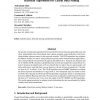125
Voted
JMLR
2010
14 years 7 months ago
2010
Current methods for causal structure learning tend to be computationally intensive or intractable for large datasets. Some recent approaches have speeded up the process by first m...
96
Voted
JMLR
2010
14 years 7 months ago
2010
We present two Bayesian algorithms CD-B and CD-H for discovering unconfounded cause and effect relationships from observational data without assuming causal sufficiency which prec...
75
Voted
JMLR
2010
14 years 7 months ago
2010
For a given target node T and a given depth k 1, we propose an algorithm for discovering a local causal network around the target T to depth k. In our algorithm, we find parents,...
103
Voted
JMLR
2010
14 years 7 months ago
2010
: This review presents empirical researchers with recent advances in causal inference, and stresses the paradigmatic shifts that must be undertaken in moving from traditional stati...
124
Voted
JMLR
2010
14 years 7 months ago
2010
Directed acyclic graph (DAG) models are popular tools for describing causal relationships and for guiding attempts to learn them from data. In particular, they appear to supply a ...
104
Voted
JMLR
2010
14 years 7 months ago
2010
We propose a novel method for inferring whether X causes Y or vice versa from joint observations of X and Y . The basic idea is to model the observed data using probabilistic late...
118
Voted
JMLR
2010
14 years 7 months ago
2010
Recent evaluations have indicated that in practice, general methods for prediction which do not account for changes in the conditional distribution of a target variable given feat...
107
Voted
JMLR
2010
14 years 7 months ago
2010
The NIPS 2008 workshop on causality provided a forum for researchers from different horizons to share their view on causal modeling and address the difficult question of assessing...
132
Voted
JMLR
2010
14 years 7 months ago
2010
This paper presents a game theoretic approach to causal discovery. The problem of causal discovery is framed as a game of the Scientist against Nature, in which Nature attempts to...
103
Voted
JMLR
2010
14 years 7 months ago
2010
A complex modern manufacturing process is normally under consistent surveillance via the monitoring of signals/variables collected from sensors. However, not all of these signals ...

